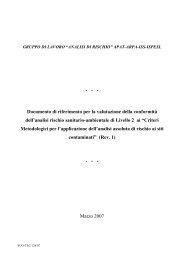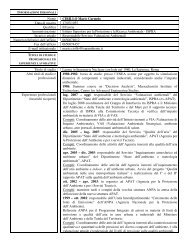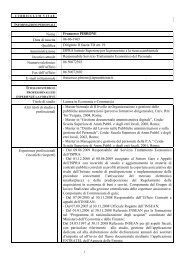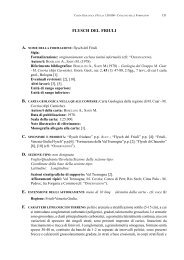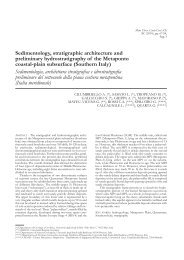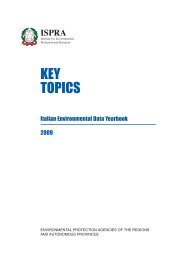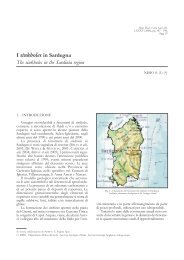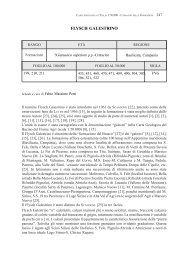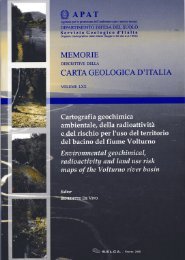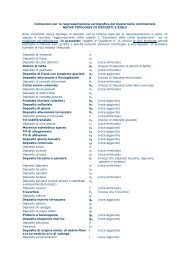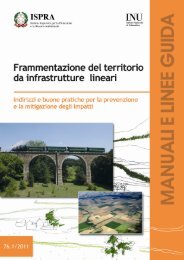Guidebook - Ispra
Guidebook - Ispra
Guidebook - Ispra
You also want an ePaper? Increase the reach of your titles
YUMPU automatically turns print PDFs into web optimized ePapers that Google loves.
THE APULIA CARBONATE PLATFORM-MARGIN AND SLOPE, LATE JURASSIC TO<br />
EOCENE OF THE MAIELLA MT. AND GARGANO PROMONTORY:<br />
PHYSICAL STRATIGRAPHY AND ARCHITECTURE P18<br />
Figure 4.1.4 - Platform derived olistolith in the lower part<br />
of the Monte S. Angelo Fm. The block is about 2 m long<br />
(road Manfredonia – Ruggiano).<br />
They are in turn overlain by turbiditic amalgamated<br />
bio-calcarenites and breccias, with scattered lenses<br />
of pelagic mudstones of Turonian age (Bosellini et<br />
al., 1993) that mark the base of the Monte Acuto Fm<br />
(Figure4.1.3).<br />
Stop 4.2:<br />
Panoramic view of Val Carbonara section<br />
The stop provides a panoramic view of the southern<br />
fl ank of Val Carbonara, between Monte degli<br />
Angeli and the town of Monte S. Angelo to the east<br />
(Figure4.2.1). The fl at-lying platform deposits of<br />
Monte degli Angeli, mainly consisting of rudist, coral<br />
and sponge boundstone, grade to the east (Madonna<br />
degli Angeli) into clinostratifi ed slope deposits,<br />
belonging to the Mattinata Fm (Bosellini et al., 1993;<br />
Luciani and Cobianchi, 1994). Further east (near the<br />
town of Monte S. Angelo), the slope deposits are<br />
truncated by the basal megabreccia of the Monte S.<br />
Angelo Fm (Figure4.2.2). The whole succession could<br />
be subdivided in two parts rich in resedimented beds<br />
(breccia and calciturbidites) separated by a wedge of<br />
pelagic lime mudstones of Aptian age belonging to<br />
the Marne a Fucoidi Fm (Figure4.2.3).<br />
Stop 4.3:<br />
The lower part of the Monte Acuto Formation<br />
The lowermost part of the Monte Acuto Fm<br />
(Figure4.3.1) is represented by a pelagic-dominated<br />
interval, about 10 m thick, mainly consisting of<br />
thin-bedded whitish lime mudstone with planktonic<br />
foraminifers of the Helvetoglobotruncana helvetica<br />
Zone (Turonian) (Luciani, 1993) (Figure4.3.2) that<br />
sharply cover the Monte S. Angelo Fm. Thin lenses<br />
and layers of chert occur in the middle part of the unit<br />
and thin bioclastic calciturbidites are intercalated in<br />
the upper part of the interval, recording the beginning<br />
of the carbonate production and exportation along<br />
the slope and base-of-slope settings. The pelagic<br />
interval is deeply truncated by a megabreccia body.<br />
The upward succession consists mainly of alternating<br />
calciturbidites beds, frequently organized into<br />
Figure 4.1.5 - Onlap of coarse bioclastic grainstone to rudstone (interval b in Figure 4.1.3) over the basal megabreccia<br />
body in the Ruggiano section.<br />
35 - P18<br />
Volume n° 3 - from P14 to P36



